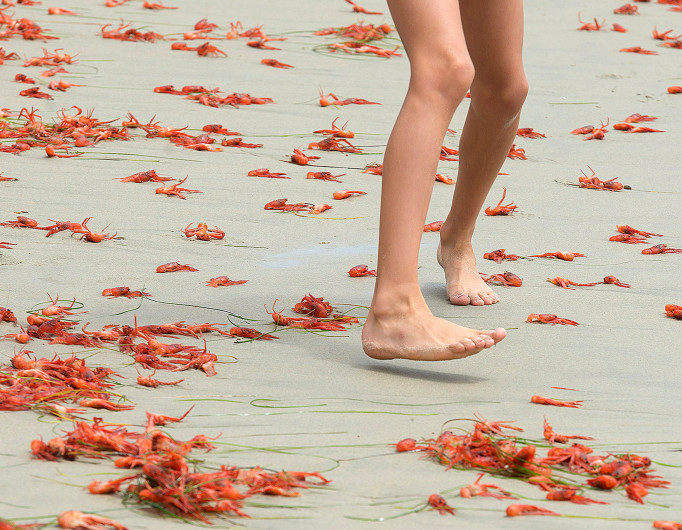
© Cindy YamanakaThousands of tiny red crabs wash ashore on Catalina Island
A trip to Catalina Island this week became a lesson in marine biology, with tiny red crabs washing ashore in the thousands and dozens of kids working tirelessly to try to save them by returning them to the sea.
Micah Stovall, of Huntington Beach, took a quick vacation to Catalina with family in town from Tennessee when they noticed the small creatures along the shore and in the shallow waters at the main beach in Avalon.
Stovall knew right away what they were: small crabs that look like tiny lobsters or crawfish. He had ventured with his family two years ago to Balboa Island in Newport Beach when hundreds of thousands of them blanketed the shore.
The
Pleuroncodes planipes, also known as pelagic red crabs or tuna crabs, are about one to three inches long.
They are usually found off Baja, but warm water in the past few years has pushed them up to Southern California in large numbers, especially along the Orange County coastline. Before then, the crabs hadn't been seen in the area for decades.
While El Nino was credited for the invasion the past few years, the water has returned to normal, colder temperatures this year. But a south swell in recent days has helped push warm water to the coastline, in many areas boosting water temperatures near 70 degrees.
Their sudden appearance can be a headache for maintenance workers as they try to scoop up the mostly dead creatures that leave a strong stench when they wash ashore and bake in the sun for too long.
In June 2015, they showed up in the hundreds of thousands from Huntington Beach to Dana Point. Last year, they appeared at Dog Beach in Huntington and parts of Newport Beach in May.Mike Pisani, municipal operations director for the city of Newport Beach, said he has not seen any washing ashore on local beaches — yet.
"It probably means they are coming though," he said upon hearing they were washing up on Catalina.
In some cases, for beaches that are in protected zones that have strict restrictions on removing creatures, there's no choice but to wait until the tides wash them away or sea gulls feast on them, leaving less-than-ideal conditions for beachgoers looking for pristine sand to lay their towel out on.
Todd Mansur, captain for Dana Wharf Sportsfishing and Whale Watching, said he's seen them offshore in deeper waters near Catalina.
"They are all over the place," he said.
But he's unsure if they'll reach Southern California beaches.
"South swells, murky waters, different currents will probably keep that stuff off the beaches for awhile," he said. "It's unlikely coming any closer because of the conditions we have."
Julianne Steers, director of husbandry at the Ocean Institute in Dana Point, said a research group saw the red crabs in big numbers two miles from Dana Point last week.
"We had a massive collection of them, more than 100 pounds," she said. "Our net was full."
While most were returned to the ocean, a few were kept for research.
"We release them, but we usually take a few so we have them to study and learn from for those who can't get out in the field to see them," she said. "When we have that quantity of them, we let them live out there and let them continue to be part of the food chain."
Whether they'll come washing ashore on local beaches is unknown.
"It just depends on where the swell will be heading," she said. "It's a combination of the two — the swell and the currents."
Spencer Gilbert, a Los Angeles County lifeguard, said they aren't carpeting the beaches on Catalina like they did last year, but they are "definitely making an appearance."
He said thousands of them started showing up Sunday, and people have been collecting them in buckets and dumping them back in the ocean.
Stovall's 8-year-old triplets, other family members and about 100 other children helped in the effort.
"My girls were fearless, they were stoked on it," he said.
He didn't dampen the kids' efforts with the harsh reality of Mother Nature.
"The lifeguard said, 'You can try as hard as you want. They are open-ocean animals. They are done,'" Stovall said.
Reader Comments
to our Newsletter